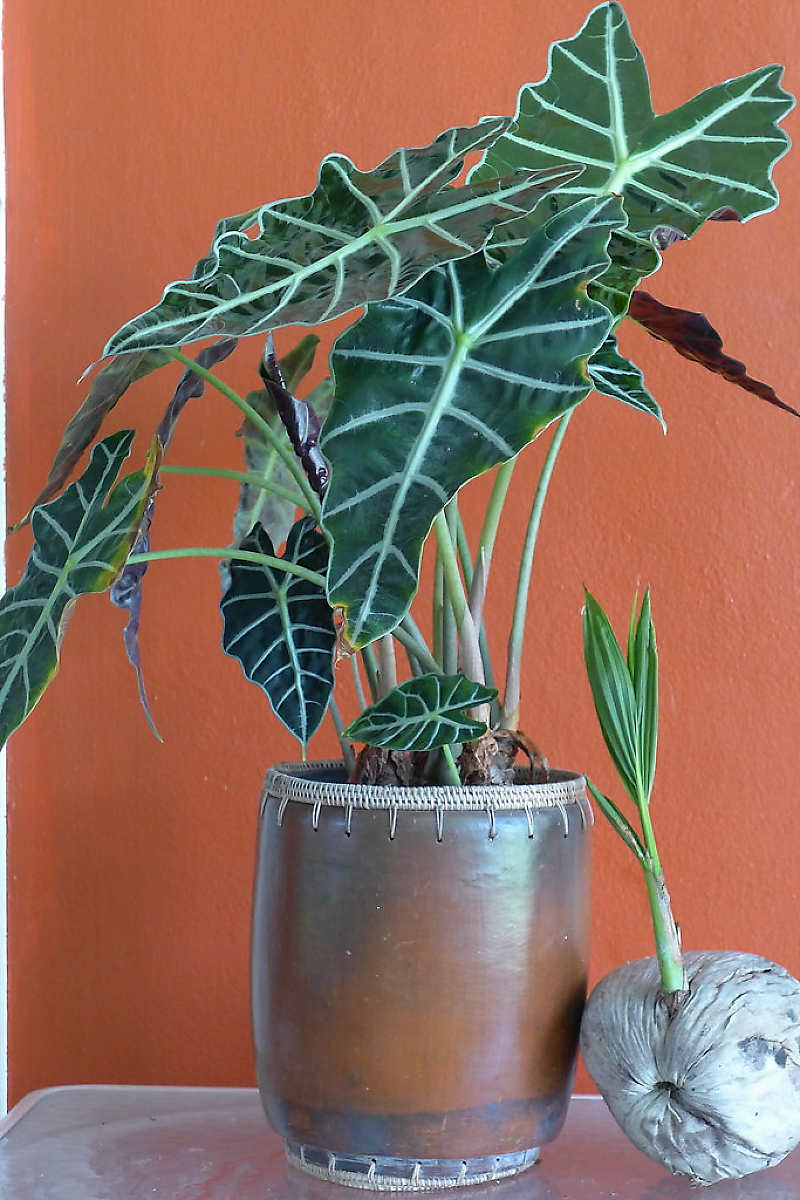Your cart is currently empty!
Alocasia Polly Care for a Stunning Plant
The Alocasia Polly is a show-stopper with the perfect contrast. It’s native to Southeast Asia and Australia. The distinct and beautiful leaves of the Alocasia Polly make it an instant favorite. However, this beloved is a bit difficult to keep pleased, which is why we’re here to assist!
Your Alocasia polly will bloom if the conditions are favorable. The flowers on Alocasias have a spathe and spadix, but the leaves generally hide them. The foliage of Alocasia is what makes it such a stunning plant. However, they can be toxic if ingested, so stay alert if you have a kid or pets in your house. Also, here are other Alocasia Polly care tips for interested plant parents.
Quick Growing Guide

Botanical Name: Alocasia amazonica ‘Polly’
Also Called: Alocasia Poly, African Mask plant, Amazonian elephant ear
En français: Alocasia amazonica Polly
Sun / Shade:
Water: Regularly, don’t over water
Soil:
Height:
Width:
Care:
Soil Requirements
The plant requires humus-rich soil with the optimum living circumstances. The finest damping conditions must be maintained on the earth. For free circulation and to avoid root rot, keep the soil porous as much as feasible.
The plant thrives in a soil environment that allows for drainage. The topsoil should be moist enough but not soggy to allow the excess water to stay inside the root zone.
The soil utilized for the plant can be mixed with coco peat or mossy peat, both of which allow moisture to be retained and provide ample surplus water. The peat also serves to oxygenate and protect the roots from rotting. The plant requires adequate room to thrive and develop tall.
Water
When it comes to watering Alocasia, there are times when it might be difficult. These easy-care houseplants like well-draining soil and like being watered after the top few inches of dirt have dried out. While they may tolerate wet conditions, they dislike being trapped in standing water, so make sure to empty the cache pot or saucer after watering.
Keep in mind that these plants thrive on lots of light, so if they are in a sunny location, the soil may dry out faster.
Light
Alocasia plants have large leaves, which is why they are popular houseplants. Even though our Polly begins small, it will develop large leaves because of its massive leaves. As a result, Alocasia houseplants require a lot of sunshine.
The ideal location will have medium or bright indirect light. Direct sunlight is harmful, so it should be avoided. You should ensure that your Alocasia Polly receives at least six hours of sunshine daily. This will aid in growing big, healthy leaves on the plant.

Temperature
The Alocasia Polly is a subtropical plant that thrives when kept warm. Alocasia prefers an environment that is neither too cold nor hot. Although, if you prefer to blast the air conditioning in the summer, your Alocasia may appreciate it even more if it’s not in a temperature-controlled room.
Alocasia, on the other hand, thrives in a shaded location on a deck, patio, or balcony during the summer months. However, before the temperatures drop below 60°F, move it back inside.
Humidity
Alocasia Polly thrives in high humidity. This houseplant thrives under humid conditions. During the dry winter season, place Alocasia near a humidifier or a pebble tray with water to ensure optimum growth. Houseplants like these don’t require additional moisture in the summer, but if you notice the leaves curling or the edges drying and crispy, increase the humidity.
Fertilizer
Alocasia plants generally require more fertilizer than other tropical plants. Although Alocasia is very durable, regular fertilization is beneficial to them. Pushing out large, beautiful leaves takes a lot of effort, and feeding the plant with a quarter-strength diluted complete liquid solution or seaweed or fish emulsion will assist.
Every other week, fertilize Alocasia Polly when the plant is actively growing in the spring and summer. When your Alocasia is dormant during the winter, take a break from fertilizing it. Similar to how protein in the diet is essential for animals and humans, a balanced proportion of Phosphorus, nitrogen and potassium is necessary for these plants.
The small indoor palms are low-growing plants that grow only about 2 feet tall.
Pruning
This magnificent plant does not require much trimming since it is not a climber. However, trimming is required to make space for additional leaves and stems from growing if they become overgrown. Trimming also results in longer-lasting foliage.
Tips on Alocasia Polly
- The Alocasia’s foliage is the true star, although these plants produce blooms. The flowers, on the other hand, are usually little. You may either leave the blossoms on and remove them after they have faded or prune them off as soon as they begin to appear. The flowers should be removed without damaging the plant, which allows the Alocasia to redirect that energy into new growth.
- Alocasia plants produce from rhizomes, so the best way to propagate them is through division. Keep the thick, tubular roots separate and repot into individual containers when repotting. It’s usually preferable to divide a plant in the early spring.
- Rotate the pot to ensure that all sides of the Alocasia get equal amounts of light. The upside-down state will encourage the leaves to grow upward instead of toward the light, ensuring they remain upright.
Author
My name is Olivia, a plant loving writer who writes for Plantscraze.com and theridingkid.com. Whenever I get some time for myself, I spend it by either tending to my garden, reading a book or riding my bicycle. I also do freelance writing from time to time.
Share with Family and Friends
Featured Authors
Visit a Botanical Garden For Unique Experiences.
Comments
Logging in to comment gives you more features, but it is not required.
Subscribe
0 Comments
Oldest












